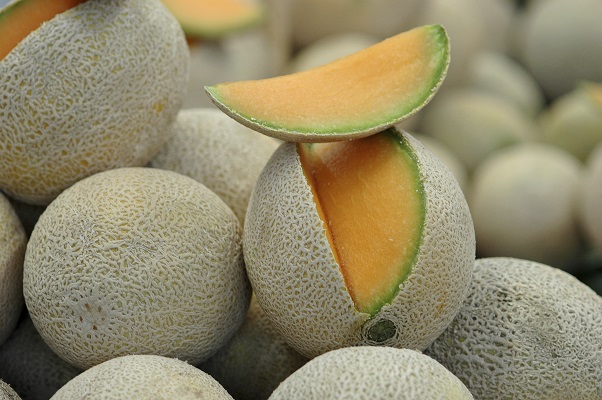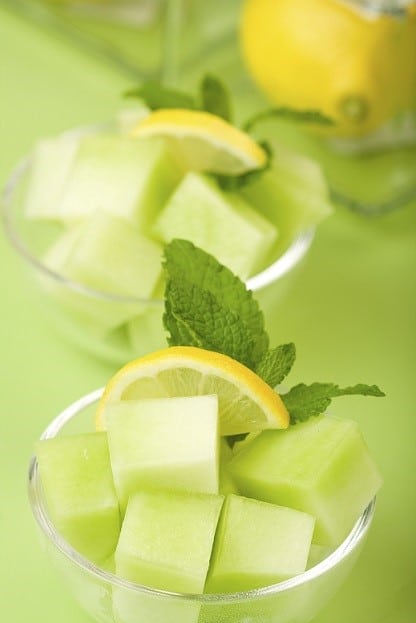 The melon, AKA the Cucurbitaceae family of fruits, is a popular berry fruit with at least 25 varieties worldwide.
The melon, AKA the Cucurbitaceae family of fruits, is a popular berry fruit with at least 25 varieties worldwide.
There’s the obscure spiky horned melon, which is popular in Africa. There’s the Chinese hami melon, the Korean melon, sugar melon, and the tiger melon. Contrary to popular belief, the watermelon IS a type of melon.
The most popular varieties are undoubtedly the cantaloupe and honeydew melons, both of which have been on the menu of mankind for over 4000 years. Cantaloupe (known as rockmelon in Australia) was grown in the Nile River Valley of Ancient Egypt, while honeydew melons first appeared in Egyptian hieroglyphics dating back to 2400 BC. Napoleon considered the honeydew to be his favourite fruit.
These days, China grows and sells nearly half the world’s cantaloupe supply, at 25 billion pounds per year. This is followed by Turkey at 3.5 billion pounds, Iran at 2.9 billion pounds, Egypt at 2.4 billion pounds and the USA at 2.2 billion pounds. Within the USA, California grows nearly half the country’s produce, followed by Arizona, Colorado, Georgia, Indiana, and Texas.
Today, we will continue our quest to rank every common fruit for acne, by analysing both cantaloupe and honeydew melons.
Are melons rich in acne nutrients?
100 grams of cantaloupe melon, or about a bowl’s worth, contains the following vitamins and minerals:
- Vitamin C – 61%.
- Vitamin A – 68%.
- Calcium – 1%.
- Iron – 1%.
- Vitamin B6 – 0%.
- Vitamin E – 0%
- Vitamin B12 – 0%.
- Choline – 7.6mg.
- Manganese – 2%.
- Selenium – 1%.
- Potassium – 8%.
- Magnesium – 3%.
- Vitamin D – 0%.
- Zinc – 1%.
- Sugar – 7.9g.
- ORAC score – 319.
Cantaloupe melon is immediately a good source of vitamin A (in plant-based carotenoid form) and vitamin C. We’ve raved about those two nutrients in this article, so in brief, vitamin C clears acne by lowering stress hormone levels and accelerating collagen production. It’s also the most abundant water-soluble antioxidant in the human body.
Vitamin A directly controls both the skin’s oil and keratin protein production, the two main villains behind clogged pores. Vitamin A also provides a natural armour against free radicals from sunlight, allowing you to make more vitamin D without inflammation.
Do melons deserve to become the new superfood craze for clearing acne then? The answer is definitely no.
Why? Simply because if you visit any marketplace in any town or city, almost every fruit and vegetable for sale will contain just as much vitamin C.
For instance: a handful of strawberries contains 97% of the RDI per 100 grams, raspberries contain 43%, oranges 88%, and pineapple (a surprisingly good source) 79%.
That’s only among fruits, as broccoli contains 148% per 100 grams, kale has 200%, spinach 46%, and potatoes 32%. The vitamin C in melons is great for acne, but no reason to specifically hunt them down.
Likewise, if you choose sweet potatoes for your evening carb source, you’ll acquire 566% of the RDI for vitamin A per 200 grams. Comparing cantaloupe melon to sweet potatoes is like comparing a rusty old Wild West bicycle to a 200mph freight train. Similarly, carrots provide 334% (per 100 grams), kale provides 199%, and green leaf lettuce has 148%.
Read Annihilate Your Acne – get the ultimate diet and clear your acne permanently!
The prospects for the poor old honeydew melon are even grimmer. The trace minerals and vitamins are virtually identical, but there’s only 30% of the RDI for vitamin C and just 1% for vitamin A. The lack of vitamin A is evident in the green colour, as it’s carotenoids which provide the orange hue of cantaloupes.
Cantaloupe melons are relatively rare as a fruit with decent vitamin A quantities, as only mangoes (21%) and papaya (19%) come close. However, they’re still obsolete next to most vegetables.
Antioxidant analysis
Antioxidants are a top reason to eat fruits for acne, but melons don’t contain many. The cantaloupe’s ORAC score of 319 is feeble compared to the strawberry with 4302. A honeydew scores only 253.
Pineapple (456) and watermelon (142) rank similarly, but neither cantaloupe nor honeydew have the fascinating hidden powers of those fruits (see below). Their magnesium is feeble, which slowly but surely accumulates when you eat bananas (7% of RDA), blackberries (5%) and raspberries (5%).
They also lack interesting phytonutrients. Sure, the cantaloupe has a handful of carotenoid antioxidants like lutein, but compare that to the good old banana, which comes drenched in rutin, quercetin, kaempferol, and tryptophan.
The top 7 topical treatments for clearing acne naturally
Melon-lovers might argue that science has not identified the special compounds yet, and that’s definitely possible. However, the same argument could be made for bananas as well.
Do melons have unique acne-clearing powers?
Fruits aren’t acne-friendly just for their basic nutrients, but their never-ending array of smaller plant compounds. Hence, there’s always opportunities for unique acne benefits in fruits, such as:
Pineapple – contains bromelain, which accelerates protein digestion and lowers inflammation.
Pomegranate – contains phytonutrients which inhibit the creation of stress hormones. The best fruit for antioxidants.
Watermelon – increases nitric oxide levels due its l-citrulline content.
Oranges – may detoxify elevated estrogen levels.
Red grapes – contain resveratrol, a popular supplement which stimulates your body’s natural antioxidant creation.
Unfortunately, if you’re diehard melon fan, neither cantaloupe nor honeydew have any such standout powers. An extensive trawling of all available studies reveals nothing.
Now, this could be forgiven if the melon had some really solid nutrition for acne. For example, blueberries aren’t unique at all, but they still lower inflammation and free radicals far more powerfully than usual.
However, melons seem weak even for standard anti-inflammatory powers (common in fruits). There is this one promising study:
- Scientists led by Dr I Vouldoukis applied cantaloupe melon extract to cell cultures and tested their immune system cytokine content. The pro-inflammatory TNF-a fell, while the anti-inflammatory interleukin-10 (IL-10) rose. In a second experiment, scientists injected some mice with either a placebo or the cantaloupe melon extract (CME), while also injecting the pro-inflammatory chemical IFN-gamma. The melon-injected mice enjoyed more protection against inflammation.
That’s a decent result, but it’s only one study. Apples, oranges, and strawberries have fistfuls of superb anti-inflammatory studies to their name. Furthermore, the first part was on cells (in vitro), not on living humans with all their bodily complexity. Part 2 was on mice, which are obviously not identical to humans. Mice studies are very useful, but mainly when they’re combined with rat and human studies elsewhere, because then they’re merely solidifying an existing theory.
Likewise, it’s promising that TNF-a and IFN-gamma fell, but they’re only two pro-inflammatory chemicals among a wider immune system arsenal.
Some great fruits often have no studies themselves, but several compounds which are proven to be anti-inflammatory, like the the resveratrol in grapes or the pterostilbene in blueberries. However, the same can’t be said for melons.
Elsewhere, melons have few decent studies for other classic acne powers, such as controlling stress hormones, improving insulin sensitivity, or accelerating glutathione production.
For some reason, nobody has bothered to research cantaloupe or honeydew melons at all. Either that, or scientists across the world are aware of how little nutritional power they possess, and steer well clear.
Vital reading: the top 6 vitamins and minerals for radiant and clear skin
They do have some good points, like a low sugar content for fruits, of 7.9 grams (cantaloupe) and 8.1 grams (honeydew). They’re also low in FODMAPs, poorly digested carbohydrates which trigger digestive difficulties and acne in sensitive people.
Neither melon has obvious compounds that could trigger acne in sensitive people, like the glycoalkaloids in tomatoes. However, they also contain only 1 gram of fiber per 100 grams, and therefore won’t feed your healthy gut bacteria like apples or bananas.
History reveals no benefits for acne either
 One of the most interesting signposts of a food’s acne-clearing potential is the path it once forged through history.
One of the most interesting signposts of a food’s acne-clearing potential is the path it once forged through history.
For instance, us 21st century dwellers know that bananas are highly anti-inflammatory through science, but numerous ancient civilisations realised the same solely through their experiences.
Archaeologists believe that the domestic banana originated from the Kuk valley of New Guinea in 8000BC. Since then, they’ve been used for treating hangovers, stained teeth, mosquito bites, indigestion, obsessive food cravings, and kidney stones by various ancient schools of medicine.
With melons, we know they’ve been around a heck of a long time. The cantaloupe first originated in either Middle East or India, and the ancient Egyptians and Romans definitely grew melons.
Cantaloupe was introduced to Europe back in the 15th century and quickly became a popular fruit due to its sweetness. They’re actually named after the papal gardens of Cantaloupe, Italy, the first European location where they were planted according to historians. Cantaloupe melons were first introduced to North America by Christopher Columbus during his second expedition there in 1494.
Vitamin E – the ultimate nutrient for clogged pores
Honeydew melons, meanwhile, are even more ancient, first cultivated in Northern Africa and Persia nearly 4,000 years ago. Spanish missionaries brought them to California in 1683, and as we mentioned earlier, Napoleon was obsessed with them.
Yet throughout this long history, there are few stories of melons being used for warts, inflammation as an aphrodisiac, for hangovers, or any medical purpose.
This again hints that cantaloupe and honeydew melons are at the bottom of the pile for acne.
Verdict – one of the weaker acne fruits
Both cantaloupe and honeydew melons have decent amounts of vitamin C, but a serious shortage of any unique properties for acne. The cantaloupe’s richness in vitamin A stands out, but even that power can be found elsewhere with ease.
Melons undoubtedly rank below strawberries, pineapples, or pomegranates in the halls of acne-clearing fruits. Despite this negativity though, a nice, sweet bowl of cantaloupe melon is easily better for your skin than a greasy donut or giant cookie. Furthermore, there’s no reason to avoid these melons, as their sugar content is relatively low. There’s still a possibility of undiscovered acne-clearing properties.
Hence, if you’re already a huge fan of cantaloupe or honeydew melon, it’s a great idea for acne to keep going.
NEXT: get the complete strategy for clearing acne naturally
Thanks for reading!
